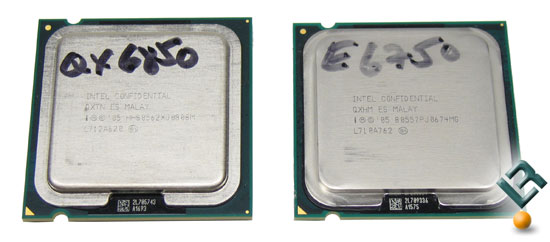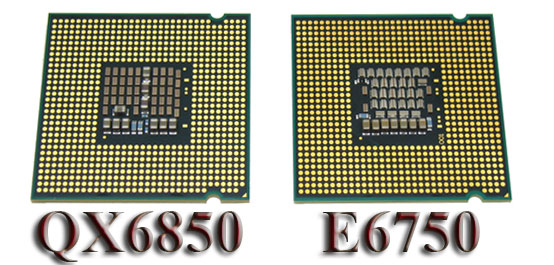Intel 1333FSB Processors Arrive – QX6850 and E6750
Intel Increases The Bus Speed and Lowers Prices
At the beginning of this week, Intel officially introduced their flagship Core 2 Extreme QX6850 quad-core processor to go along with the recently announced Core 2 Duo E6550, E6750 and E6850 series processors. While all these processors have different model numbers, they do have one thing in common, a new faster 1333MHz Front Side Bus (FSB) for improved performance that has replaced the old 1066MHz FSB. For overclockers this is nothing new as reaching a FSB of 1333MHz could easily be reached with the right hardware, but now with the introduction of the Intel P35 ‘Bearlake” chipset and upcoming X38 chipsets, a FSB of 1333MHz is now supported without ‘overclocking’ the system components. Other than Intel chipsets, third party chipset designers like NVIDIA also support these new 1333MHz FSB processors, giving consumers a multitude of boards to pick from when building a new system.
For our dedicated readers that came looking for our launch article a few days ago and didn’t find it, please note that we were waiting on something to be sent to us before running all of our benchmarks. For these new 1333MHz processors we wanted to run them on the ASUS P5K3 Deluxe motherboard with latest and greatest DDR3 memory. Just this past week Kingston Technology announced a new HyperX kit that operates at 1333MHz with 5-7-5-15 timings and since none of the four brands of DDR3 have reviewed offer timings tighter than CL7 timings we made the move to wait. By chosing to wait, it delayed the article by several days, but by doing so improved the system’s performance by a significant amount (greater than five percent in a number of cases).
Now that we are armed with the latest memory, chipsets and motherboard BIOS revisions, Legit Reviews will be covering both the new Core 2 Extreme QX6850 quad-core processor and the Core 2 Duo E6750 dual-core processor. Both offer the new 1333MHz FSB and are monsters when it comes to performance and overclocking as you are about to find out.

Looking at the QX6850 and the E6750 the look identical, but don’t let the looks deceive you. The Intel Core 2 Extreme QX6850 is a quad-core processor, running at 3.0 GHz with 8MB of L2 cache and features a Thermal Design Power (TDP) of 130W. The Intel Core 2 Duo E6750 is a dual-core processor, running at 2.66GHz with 4MB of L2 cache and features a TDP of 65-75W. Other than those key differences, both processors are nearly identical as they are built with the same 65nm manufacturing process and contain Intel Core 2 microarchitecture.

If you are already wondering when these bad boys will be available, Intel has informed Legit Reviews that all of their 1333 MHz FSB parts should be available at your favorite retailer in roughly two weeks or so. As previously mentioned, LR will just be covering the Core 2 Extreme QX6850 and the Core 2 Duo E6750 in this article, but Intel is also launching two other processors today: The Core 2 Duo E6850 and Core 2 Duo E6550. This means that Intel now has four 1333MHz FSB parts on the market today that range in price from just $163 all the way up to the multiplier unlocked Core 2 Extreme QX6850 for $999.
| Processor | Cores | Frequency | Front-side Bus | L2 Cache | Price |
| Core 2 Extreme QX6850 | 4 | 3.0 GHz | 1333 MHz | 8 MB | $999 |
| Core 2 Quad Q6700 | 4 | 2.66 GHz | 1066 MHz | 8 MB | $530 |
| Core 2 Duo E6850 | 2 | 3.0 GHz | 1333 MHz | 4 MB | $266 |
| Core 2 Duo E6750 | 2 | 2.66 GHz | 1333 MHz | 4 MB | $183 |
| Core 2 Duo E6550 | 2 | 2.33 GHz | 1333 MHz | 4 MB | $163 |
These new prices are by far the most exciting part of this product launch as last week Newegg was selling the Core 2 Duo E6700 for $318 and now Core 2 Duo E6850 can be had $183 and has a faster Front Side Bus. With this product launch Intel has been able to improve performance and reduce prices at the same time. It’s not every day you pay less and get more, but this is obviously one of them and it happened just before the back to school shopping season. Thank the on-going price war between AMD and Intel for this one!
Let’s take a look at these new processors and see how they stack up against recent releases from AMD and Intel, but before you go on be sure to catch up on our more recent processor reviews.
-
Intel Unleashes Conroe: X6800 and E6700 Reviewed (Conroe Launch Article)
-
Core 2 Extreme QX6700 Processor Benchmarking at Intel (Private Benchmarking with Intel)
-
Intel Core 2 Extreme QX6700 Processor Review (Kentsfield Launch Article)
-
Intel Moves Closer to 45nm Penryn Processor Production (45nm Technology Information)
-
Intel Penryn and Nehalem Update (Updates on Penryn and Nehalem)
-
AMD Athlon 64 X2 6000+ Processor Review (AMD’s Latest Desktop Processor Review)
-
Intel Penryn 3.33GHz Processor Benchmarks at Intel (Private Benchmarking with Intel)

Comments are closed.